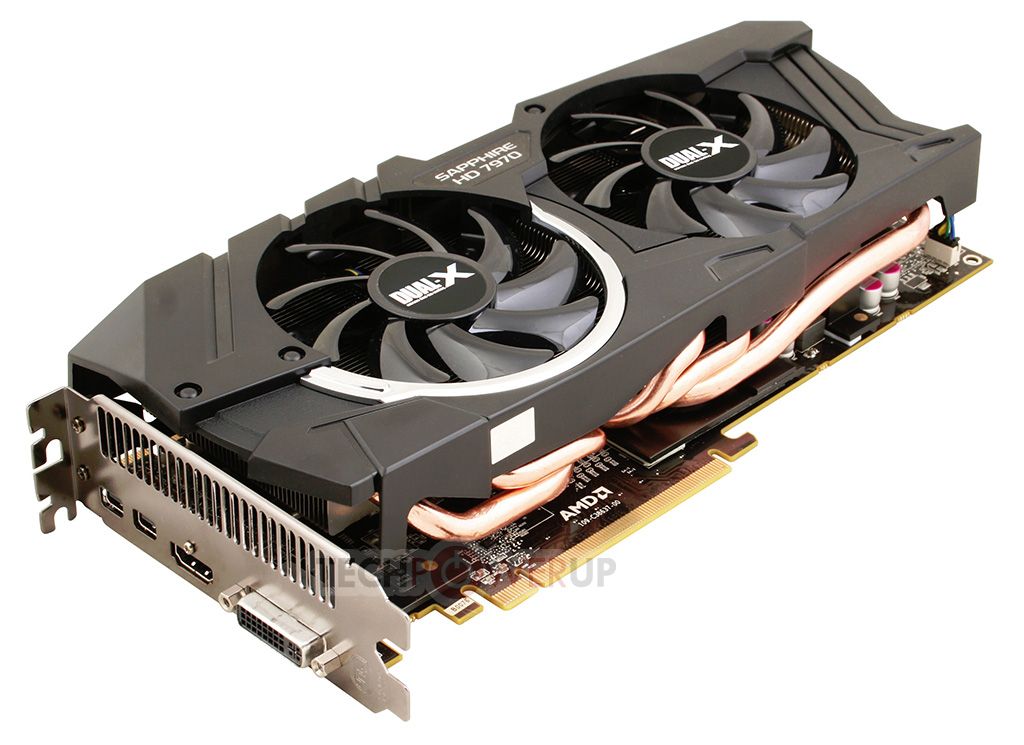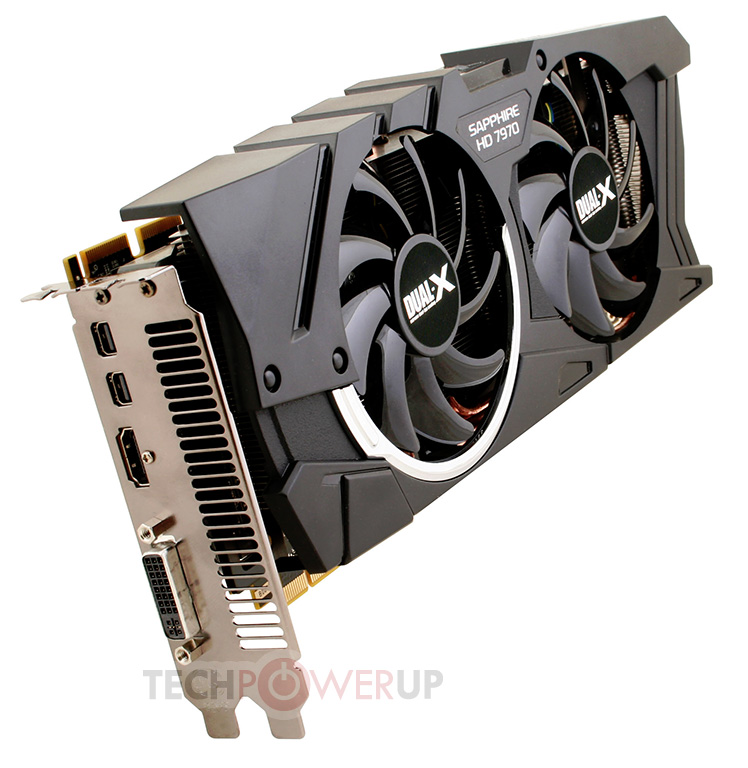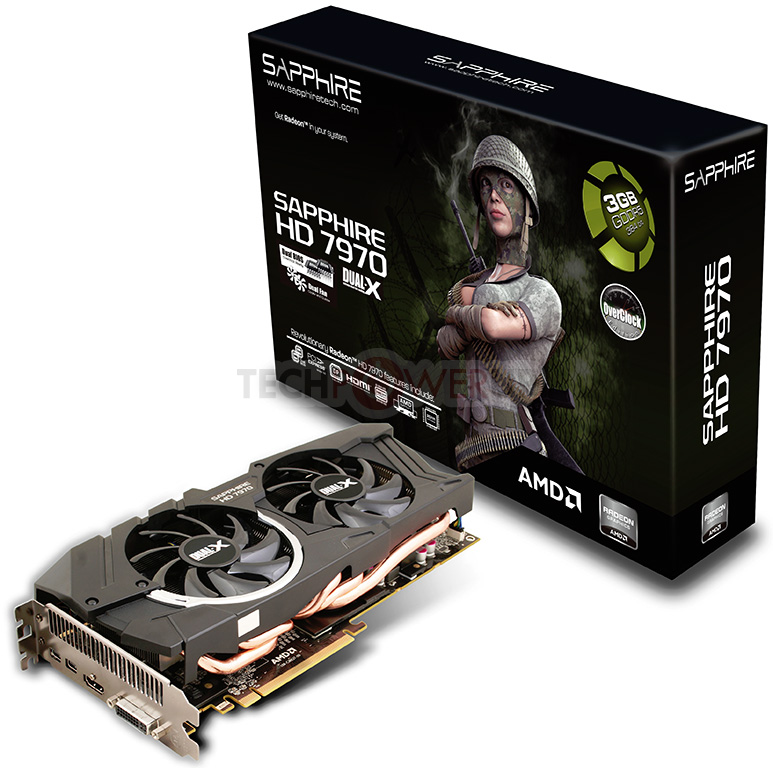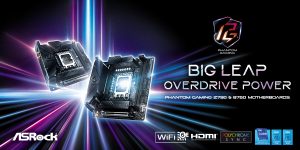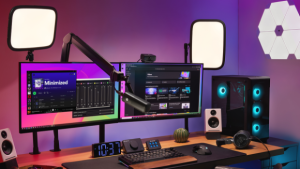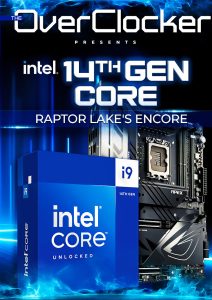SAPPHIRE Introduces HD 7970 Dual-X OC Edition
SAPPHIRE Technology has just release a new factory overclocked version of its high end graphics card based on the highly acclaimed graphics GCN (Graphics Core Next) architecture from AMD.
The SAPPHIRE HD 7970 OC Edition features SAPPHIRE’s new dual-extractor technology – Dual-X – a highly efficient multi-heatpipe cooler with dual fans providing quiet and very cool operation during normal operating conditions, and superb cooling performance even under extreme load. The HD 7970 from AMD is the most powerful single chip GPU ever built – it has a new internal structure with 32 compute units and a total of 2048 Stream processors. The SAPPHIRE HD 7970 OC Edition ships with a raised core clock speed of 950 MHz, and 1425MHz for the memory. Its Dual BIOS switch allows users to select the higher performance settings of 1 GHz core and 1450 MHz memory, making the fastest card in its class. This setting also uses a more aggressive fan profile and raises the limits for maximum overclocking.
For enthusiasts wishing to maximise performance, a new version of the SAPPHIRE overclocking tool, TriXX is available free to download from the SAPPHIRE website. TriXX allows tuning of GPU voltage as well as core and memory clocks, whilst continuously displaying temperature. Manual control of fan speed is supported, as well as user created fan profiles and the ability to save up to four different performance settings.
The HD 7000 series is the third generation of DirectX 11 compatible solutions from the graphics division of AMD – formerly ATI. The SAPPHIRE HD 7970 is ready for DirectX 11.1 and the new Windows 8 operating system as well as delivering all the features of the current DirectX 11 such as DirectCompute11 and multi threaded communications with the CPU. Communication with the host PC is optimised with the implementation of the latest high speed PCI-Express Gen3.0 interface, and multiple cards can be used to further enhance performance in CrossFireX mode on a suitably specified mainboard.
HDMI specifications have also increased in the HD 7000 series. Fast HDMI 1.4a supports Stereoscopic 3D with enhanced frame rates of 60Hz per eye – 120 Hz total. It is also ready for the next generation of 4K displays that can be driven from a single high speed input of 3GHz HDMI 1.4a or DisplayPort 1.2 HBR2.
Working or gaming with multiple monitors is becoming increasingly popular, and the SAPPHIRE HD 7970 supports this with AMD Eyefinity. With its DVI, HDMI and two mini-DisplayPort outputs the card can support configurations of up to 6 monitors. In addition, the SAPPHIRE HD 7970 is the first graphics card that can simultaneously output multiple, independent audio streams allowing the correct audio content to be associated with different applications on different screens.
APP Acceleration is the name given to the enhanced performance of a wide range of applications using the stream processing capabilities and specific hardware features of the graphics architecture. The HD 7000 series has been optimised for this type of task. Typical applications include Video encoding and decoding, compression and multiplexing for media distribution, gaming or video conferencing. APP acceleration can also enhance everyday tasks such as Internet browsing, Office applications and file compression with supported software suites.
The retail bundle for the SAPPHIRE HD 7970 OC is second to none. In addition to the standard bundle consisting of an Active mini-DP to single-link DVI adaptor for Eyefinity setup, CrossFire bridge cable, HDMI to DVI adaptor for dual DVI setup, DVI to VGA adaptor, 8 pin to 4 pin power adaptor and 6 pin to 4 pin power adaptor, SAPPHIRE also provides an extra mini-DP to DP adaptor and a 1.8 metre HDMI 1.4a cable.
The SAPPHIRE HD 7970 OC is shipping now and will be available through SAPPHIRE’s established e-tail and retail partners.
For more information, visit the product page. Pictures — techPowerUp!

